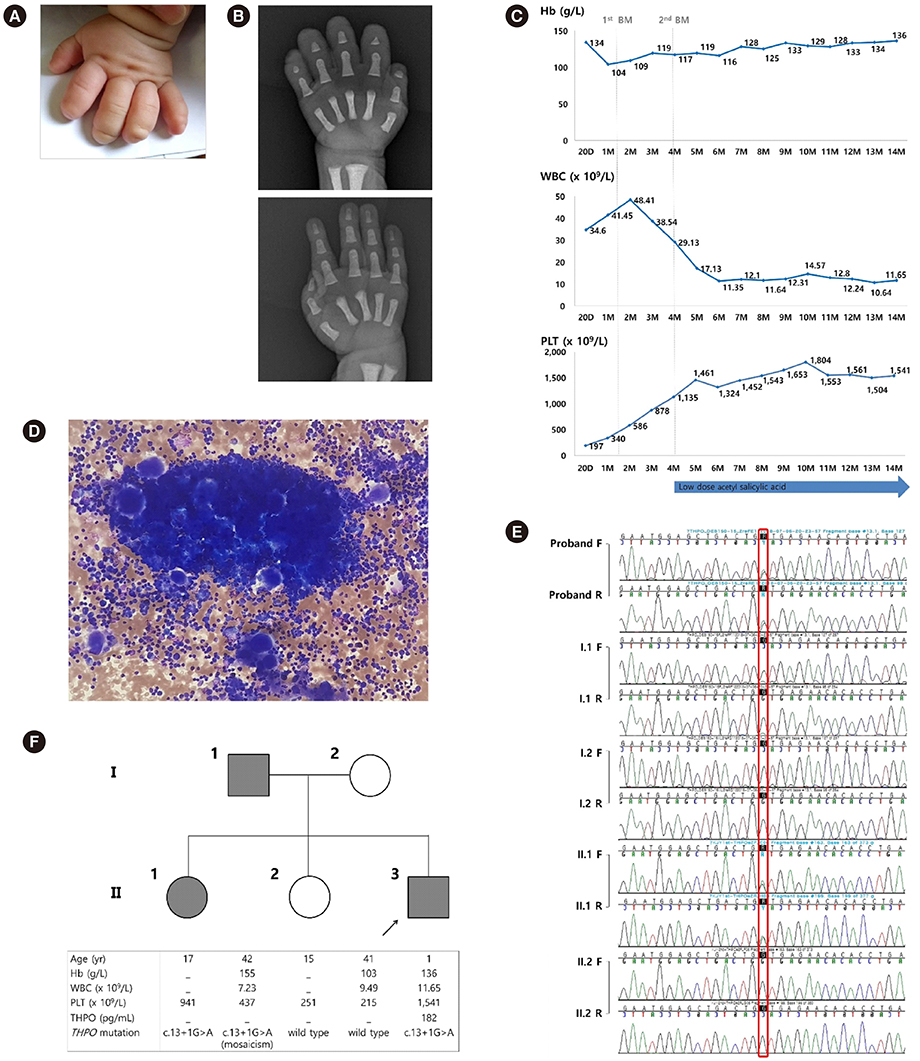Ann Lab Med.
2020 Jul;40(4):341-344. 10.3343/alm.2020.40.4.341.
Thrombocythemia 1 With THPO Variant (c.13+1G>A) Diagnosed Using Targeted Exome Sequencing: First Case in Korea
- Affiliations
-
- 1Department of Pediatrics, Keimyung University School of Medicine, Keimyung University Dongsan Medical Center, Daegu, Korea. yejeeshim@dsmc.or.kr
- 2Department of Laboratory Medicine, Keimyung University School of Medicine, Keimyung University Dongsan Medical Center, Daegu, Korea.
- KMID: 2470334
- DOI: http://doi.org/10.3343/alm.2020.40.4.341
Abstract
- No abstract available.
MeSH Terms
Figure
Reference
-
1. Graziano C, Carone S, Panza E, Marino F, Magini P, Romeo G, et al. Association of hereditary thrombocythemia and distal limb defects with a thrombopoietin gene mutation. Blood. 2009; 114:1655–1657.
Article2. Zhang B, Ng D, Jones C, Oh ST, Nolan GP, Salehi S, et al. A novel splice donor mutation in the thrombopoietin gene leads to exon 2 skipping in a Filipino family with hereditary thrombocythemia. Blood. 2011; 118:6988–6990.
Article3. Schlemper RJ, van der Maas AP, Eikenboom JC. Familial essential thrombocythemia: clinical characteristics of 11 cases in one family. Ann Hematol. 1994; 68:153–158.
Article4. Wiestner A, Schlemper RJ, van der Maas AP, Skoda RC. An activating splice donor mutation in the thrombopoietin gene causes hereditary thrombocythaemia. Nat Genet. 1998; 18:49–52.
Article5. Kondo T, Okabe M, Sanada M, Kurosawa M, Suzuki S, Kobayashi M, et al. Familial essential thrombocythemia associated with one-base deletion in the 5′-untranslated region of the thrombopoietin gene. Blood. 1998; 92:1091–1096.6. Ghilardi N, Wiestner A, Kikuchi M, Ohsaka A, Skoda RC. Hereditary thrombocythaemia in a Japanese family is caused by a novel point mutation in the thrombopoietin gene. Br J Haematol. 1999; 107:310–316.
Article7. Liu K, Kralovics R, Rudzki Z, Grabowska B, Buser AS, Olcaydu D, et al. A de novo splice donor mutation in the thrombopoietin gene causes hereditary thrombocythemia in a Polish family. Haematologica. 2008; 93:706–714.
Article8. Stockklausner C, Echner N, Klotter AC, Hegenbart U, Dreger P, Kulozik AE. Hereditary thrombocythemia caused by a thrombopoietin (THPO) gain-of-function mutation associated with multiple myeloma and congenital limb defects. Ann Hematol. 2012; 91:1129–1133.
Article9. Hitchcock IS, Kaushansky K. Thrombopoietin from beginning to end. Br J Haematol. 2014; 165:259–268.
Article10. Kuter DJ. The biology of thrombopoietin and thrombopoietin receptor agonists. Int J Hematol. 2013; 98:10–23.
Article
- Full Text Links
- Actions
-
Cited
- CITED
-
- Close
- Share
- Similar articles
-
- Exome Sequencing in Mendelian Disorders
- Xeroderma pigmentosum group A with mutational hot spot (c.390-1G>C in XPA) in South Korea
- Whole-exome sequencing analysis in a case of primary congenital glaucoma due to the partial uniparental isodisomy
- A Familial Case with Phenotypic Differences in a CAV3 Pathogenic Variant
- Whole Exome Sequencing Identifies Novel Genetic Alterations in Patients with Pheochromocytoma/Paraganglioma


